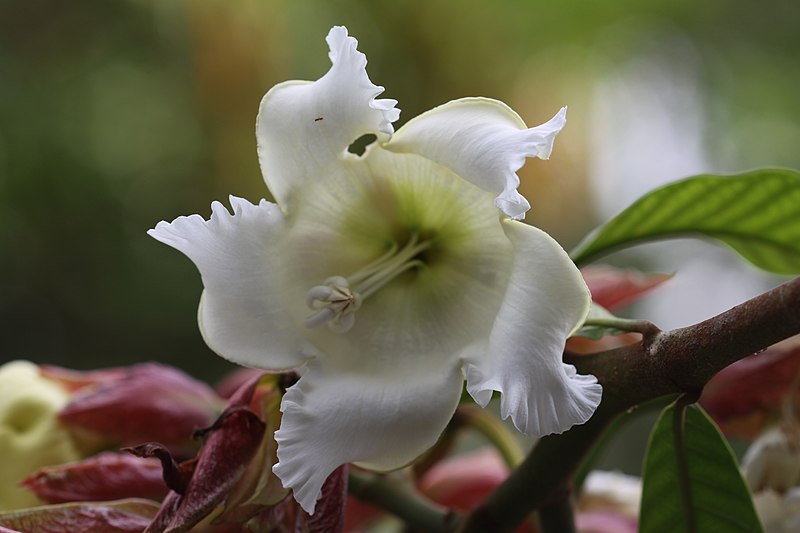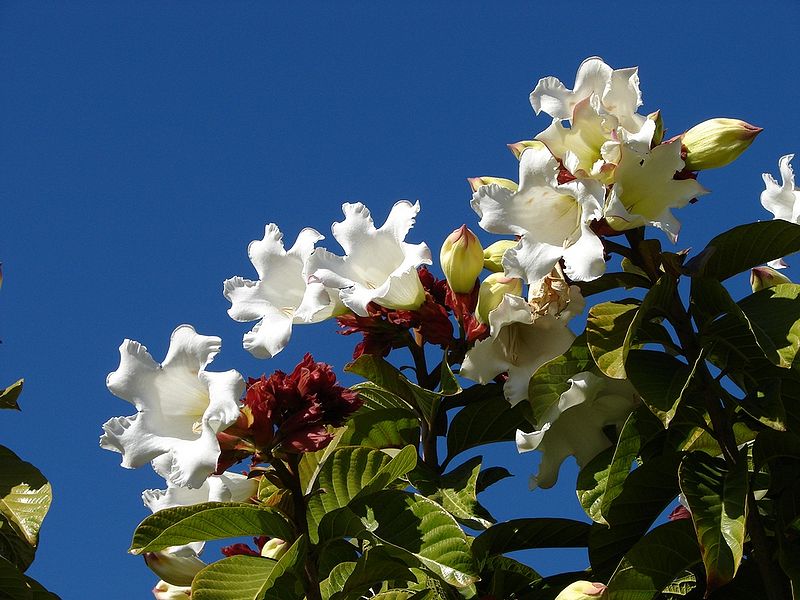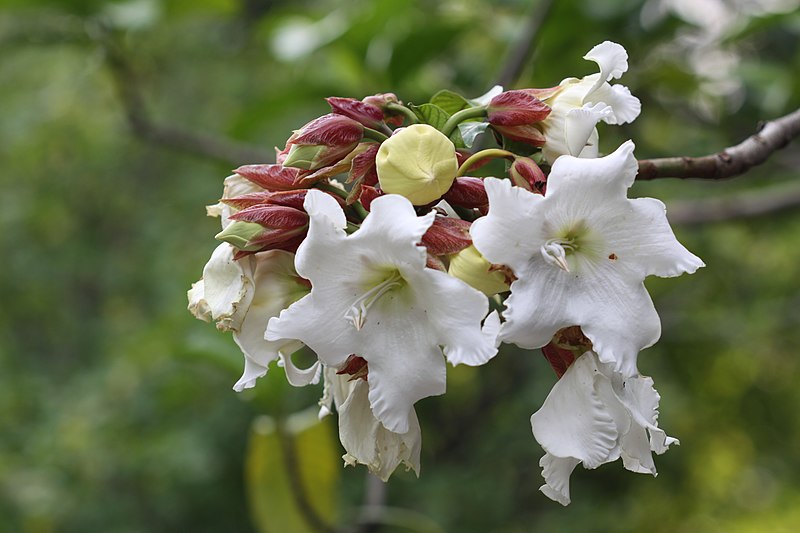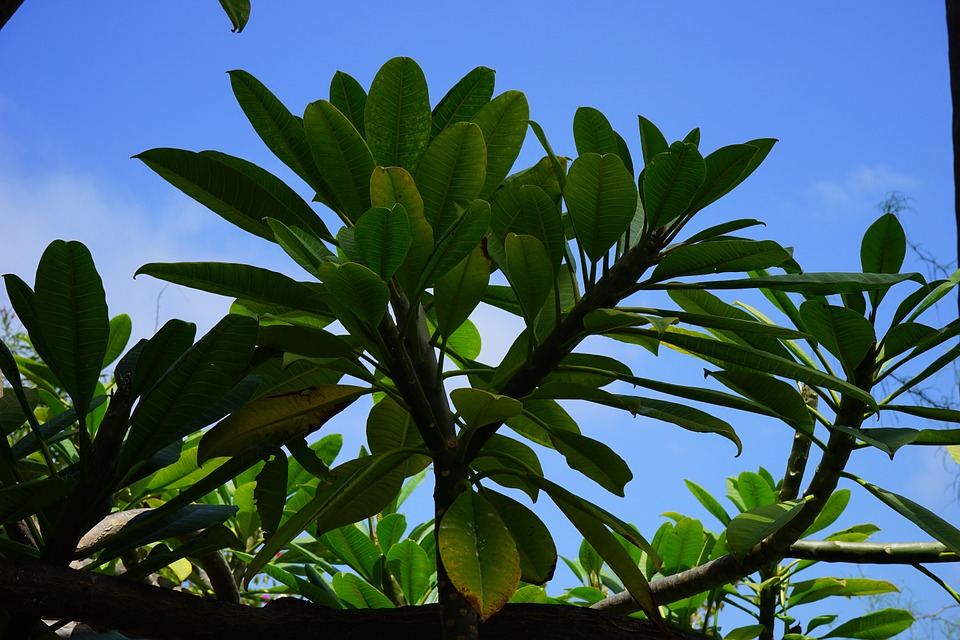

There Beaumontia grandiflora, commonly called Herald’s trumpet or heraldic trumpet, is an evergreen climbing plant appreciated for its spectacular and prolonged spring flowering.
General characteristics of Beaumontia grandiflora
There Beaumontia is an ornamental plant of the Apocynaceae family native to China. It is widespread in the areas of Southeast Asia where it grows spontaneously along the banks of rivers, in humid, valley and mountain soils, up to 1500 meters above sea level. It is grown as a vine in subtropical gardens such as Southern California.
In tropical countries the plant is evergreen while in our latitudes, in winter, it behaves as semi-deciduous, losing most of its leaves.
Read also: Coffea arabica indoor coffee plant
The Beaumontia plant is an ornamental with a climbing habit that is easy to grow even as a tree. In full vegetative vigor, an adult specimen forms a 7/8 meters tall and broad shrub with a robust and deep root system and numerous erect woody stems and hairless old ones, while the young ones are semi-woody and pubescent. The bark is smooth and dark gray in color. From the pruned or wind-shattered stems a sticky milky sap comes out.
The leaves they are large simple, opposite and about 20 cm long. The shape is ovate-elliptical, the apex round or slightly pointed, the entire edge. They are inserted on the branches through a cylindrical and hairy petiole, of a pale green color. The upper leaf plate is glossy, dark green and wrinkled due to the presence of marked veins, while the lower one is lighter. The younger leaves have a short rust-colored hair. Even from the broken leaves exudes a sticky sap.

THE flowers, similar to those of the Easter lily, are bisexual and gathered in corymb inflorescences that appear between the leaf axils. Each inflorescence is made up of 3 to 19 very large and fragrant flowers, of a white-cream color. The calyx, composed of 5 ovate-lanceolate sepals of purple red color, supports the funnel-shaped corolla, pubescent on the outside and glabrous inside, formed by 5 petals with curved outwards lobes. 5 filiform stamens protrude from the center of the corolla tube bearing yellow and showy arrow-shaped anthers.
THE fruits they are thick and woody follicles, united in pairs.
THE seeds, oblong or ovoid, they are woody compressed, contracted at the top and green in color.
You may be interested in: Cryptostegia – Cryptostegia grandiflora
Flowering
Beaumontia produces abundant and beautiful blooms in the spring-summer period.

Cultivation of Beaumontia grandiflora
The Beaumontia species is grown as an ornamental plant, with Beaumontia grandiflora being widely grown from the nursery. They prefer good soil, adequate water, and humid warm conditions. They are found planted and grown as vines in subtropical climate gardens, such as in Southern California.
Exposure
It is an exotic plant that loves full sun exposure for many hours of the day, well sheltered from strong and cold winds. It prefers the hot humid climate it tolerates winter temperatures around 0 ° C and, if protected at the base with mulching material, it resists even short frosts.
Ground
It is a plant that, while adapting to common garden soil, prefers a mixed, loose, soft and well-drained soil with a slightly acidic, neutral or alkaline pH.
Watering
Beaumontia loves moist soil so it should be watered regularly and more frequently in summer to keep the soil moist, especially if the specimen is young, planted even recently or grown in pots. In autumn and winter, water supplies must be reduced or suspended altogether if the climate is very humid and rainy.
Fertilization
The Beaumontia in order to produce abundant blooms and new branches needs a soil rich in nutrients therefore from the vegetative restart up to the whole summer. Fertilization must be done periodically by distributing a slow-release fertilizer specific for green flowering plants at the base of the shrub, balanced in macro and microelements. In autumn, on the other hand, it is sufficient to bury well-ripened manure in the soil to help the plant better withstand the cold and above all to ensure the nutrients and energy necessary for the production of new plant mass in the following spring.

Beaumontia: cultivation in pots
In regions with very cold winters, Beaumontia must be grown in pots so that it can be sheltered at home or in a cold greenhouse as soon as the temperature begins to drop.
The pot must be at least 40 cm in diameter and must also be deep enough to ensure proper root development.
A mixture of garden soil, a little sand and other drainage material for the bottom is used as a soil.
After invading, the plant should be placed in a sunny place sheltered from the wind, preferably close to a balcony or terrace wall near a grid or other type of stake to allow its branches to climb easily and without difficulty.
Watering must be done approximately every 15 days.
Fertilization must be done regularly, always using a slow release fertilizer specific for flowering plants.
As soon as the temperatures begin to drop, the plant should be moved to a sheltered but bright place, even inside the house.

Repotting
It should be done in early spring when the roots come out of the drainage holes of the pot. A wider and deeper container than the previous one and fresh and fertile soil is used.
Pruning
Beaumontia should be pruned immediately after flowering to contain its excessive development and also to favor the regrowth of new branches. The longer branches must be shortened and the dry ones eliminated completely and any parts affected by fungal diseases and those infested with parasites. Pruning should be done as always using a well sharpened and disinfected tool.

Multiplication of Beaumontia grandiflora
Reproduction occurs by seed but new specimens are generally reproduced by semi-woody cutting of basal suckers.
Sowing
It is not practiced because it takes a very long time. However, to carry it out, it is sufficient to stratify the seeds on a loose and well-drained substrate which is always kept humid, warm and in full light.
Propagation by cuttings
It should be done in late summer or autumn by practicing semi-woody cuttings of well rooted basal suckers.
After the collection made with a well sharpened and disinfected knife, the cauline leaves are eliminated, leaving only 2-3 terminal leaves suitably cut in half.
The ends of the cuttings must first be treated with rooting hormone and then buried in a mixture composed of coconut fiber, perlite and vermiculite in equal parts: 1: 1: 1.
The substrate should be watered at least once a day until the new leaves appear.
The new Beaumontia plants thus obtained must be strengthened and then transferred to their permanent residence.
Planting or planting
The Beaumontia is planted in spring or autumn in well-worked soil. The planting hole must have larger dimensions than the earth loaf and must be drained on the bottom with a layer of clay or other material covered by soil mixed with organic substance. After planting at the base of the stems a cover of straw or other mulch will also help maintain access to moisture.
Parasites and diseases of Beaumontia
It is a rustic plant subject to attacks by aphids and those of the cochineal even if rarer. It is sensitive to Punctuation, a fungal disease that causes early defoliation and manifests itself with brownish spots on young leaves and branches.
Among the fungal diseases is how the peach or other Rosaceae is sensitive to Taphrina deformans, an ascomycete fungus commonly known as peach bubble which affects especially tender leaves with visible and marked purplish-red bullous deformations. The leaves that are attacked by this fungus, which manifests itself especially when the climate is excessively rainy or humid, become fleshy to the touch, curl and finally detach from the branches. The infected plant loses slows its development and flowering.

Cures and treatments
The Beaumontia plant, like many other common climbers, in order to be able to climb easily, needs a very strong support capable of supporting the weight of its branches, especially when they are loaded with flowers. The climbing branches can be directed on resistant grids leaning against the walls or around the poles of pergolas and pergolas or the common supports of the vines.
The roots of the plant grown in the open ground must be protected from cold and frost with a mulch of dry leaves or straw.
To counteract pest attacks and to ward off fungal diseases, for preventive purposes, in autumn, it is advisable to treat the foliage of Beaumontia with specific broad-spectrum products, based on copper or horsetail.
The leaves affected by scab or peach bubble must be collected and burned to prevent them from infecting other plants.

Uses
Beaumontia is cultivated as an ornamental plant in all gardens of regions with a mild winter climate, in pots and in a protected environment in those with harsh winters. Due to its beautiful and fragrant flowering, due to its vigor, it is used in public parks and private gardens as a vertical ground cover on separation walls, as a cover for pergolas and pergolas.
In native places the …


Add comment